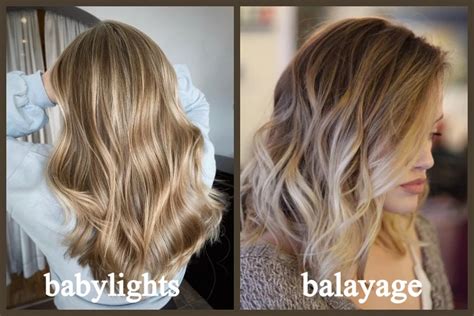Understanding the Nuances of Babylights and Balayage
Babylights and balayage are two popular hair coloring techniques that aim to enhance your locks with sun-kissed highlights. However, they differ in their methods and results.

Babylights: Delicate and Natural
Method: Babylights involve painting fine, almost invisible streaks of color onto your hair. This meticulous technique allows for a gradual transition from your base color to the highlights, mimicking the natural lightening effect of the sun.
Results: Babylights create a subtle, low-maintenance finish that blends seamlessly with your natural hair color. They add depth and dimension without overwhelming your mane.
Balayage: Bold and Dimensional
Method: Balayage is a freehand painting technique where the colorist applies highlights onto sections of hair using a paddle or brush. Unlike babylights, balayage focuses on creating bolder, more noticeable highlights.
Results: Balayage offers a more dramatic and voluminous look. The highlights are often placed strategically to frame the face and enhance your features.
Advantages and Disadvantages
Babylights
Pros:
- Subtle and natural-looking highlights
- Low-maintenance, infrequent touch-ups
- Blends seamlessly with base color
- Ideal for those seeking a conservative color change
Cons:
- Time-consuming application process
- Requires precision and expertise
- May not be suitable for drastic color transformations
Balayage
Pros:
- Bold and dimensional highlights
- Creates volume and depth
- Frames the face and enhances features
- Versatile, allowing for a range of color intensities
Cons:
- Can be more noticeable and require more frequent touch-ups
- May be less suitable for fine or thin hair
- Requires skilled application to achieve desired results
Which Technique is Right for You?
The choice between babylights and balayage depends on your personal preferences and hair needs. Consider the following factors:
- Desired highlight intensity: Babylights are more subtle, while balayage offers bolder highlights.
- Hair texture: Balayage may be less suitable for fine or thin hair.
- Maintenance level: Babylights require less maintenance than balayage.
- Budget: Balayage can be more expensive due to the time and expertise required.
Table 1: Comparison of Babylights and Balayage
| Feature | Babylights | Balayage |
|---|---|---|
| Method | Fine streaks of color painted onto hair | Freehand painting of highlights onto hair sections |
| Result | Subtle, natural-looking highlights | Bold, dimensional highlights |
| Maintenance | Low-maintenance, infrequent touch-ups | Higher maintenance, more frequent touch-ups |
| Versatility | Conservative color change | Versatile, allows for a range of intensities |
| Cost | Typically less expensive | Typically more expensive |
Creative New Word: “Luminary”
For a radiant glow that combines the subtlety of babylights with the boldness of balayage, consider the newly coined term “luminary.” This technique involves alternating fine and bold streaks of highlights to create a mesmerizing interplay of light and shadow.
Tips and Tricks
- Choose a stylist with experience in both babylights and balayage to ensure optimal results.
- Be specific about your desired highlight intensity and toning preferences.
- Protect your highlighted hair from damage with UV protectants and moisturizing masks.
- Use color-safe shampoo and conditioner to maintain the vibrancy of your highlights.
How-to: Step-by-Step Color Transformation
Step 1: Consultation
Schedule a consultation with your stylist to discuss your hair goals and desired color outcome.
Step 2: Pre-Toning
For balayage, your stylist may pre-tone your hair to lighten it slightly before applying the highlights. This step enhances color absorption and prevents brassiness.
Step 3: Sectioning and Foiling
For babylights, your stylist will section your hair and apply fine streaks of color to individual strands using foils. For balayage, the stylist will section your hair and paint highlights freehand onto the selected sections.
Step 4: Processing
The color will be left to process for a predetermined amount of time, depending on your hair type and desired intensity.
Step 5: Toning and Glossing
After processing, your stylist may apply a toner or gloss to enhance the color and add shine.
Table 2: Common Questions about Babylights and Balayage
| Question | Answer |
|---|---|
| Which technique lasts longer? | Babylights generally last longer than balayage due to their subtle, interwoven appearance. |
| Can babylights and balayage be combined? | Yes, some stylists may combine both techniques to create a multidimensional look. |
| What type of hair is best suited for these techniques? | Babylights and balayage can be applied to most hair types, but may not be suitable for very fine or damaged hair. |
| How often should I get touch-ups? | Touch-ups for babylights are typically required less frequently (6-12 months), while balayage touch-ups may be needed more often (4-8 months). |
Table 3: Color Inspiration for Babylights and Balayage
| Color | Babylights | Balayage |
|---|---|---|
| Blonde | Soft, natural-looking highlights | Bold, sun-kissed highlights |
| Brunette | Subtle, caramel-toned babylights | Rich, chestnut-hued balayage |
| Red | Ginger-spiced babylights | Copper-toned balayage |
| Black | Delicate, chocolate-brown babylights | Smoky, ash-brown balayage |
Table 4: Estimated Costs of Babylights and Balayage
| Technique | Average Cost |
|---|---|
| Babylights | $150-$300 |
| Balayage | $200-$400 |
Conclusion
Babylights and balayage are versatile hair coloring techniques that can transform your locks with a sun-kissed glow. By understanding the nuances of each technique, you can choose the one that best aligns with your personal preferences and hair needs. Remember to consult with a skilled stylist for professional advice and to ensure optimal results. Embrace the radiant glow of highlighted hair and find your perfect match with either babylights or balayage.
